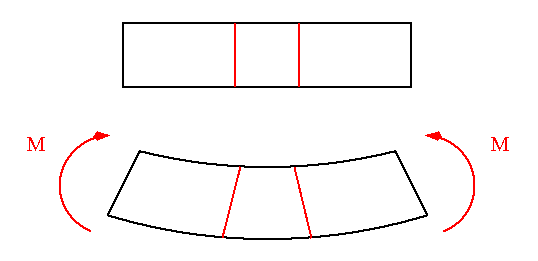

Naturally, the behavior of a beam in inelastic bending depends upon the shape of the material's stress-strain diagram. If the stress-strain diagram is known, it is possible to determine stress corresponding to a particular value of strain.
As in previous discussions we will assume that the material can be idealized as an elastoplastic material with maximum stress being the elastic limit stress, and the maximum strain being considerably higher than the elastic limit strain. It is possible for the elastoplastic material to have different characteristics in tension and in compression. For instance the corresponding elastic limit values and even the Young's moduli may be different. This tends to complicate the analysis to a certain degree.
Assumptions:
The analysis of an inelastic beam is based on the assumption that plane cross
sections of a beam remain plane under pure bending, a condition that is valid
for both nonlinear and linear materials. Therefore, normal strain in
an inelastic beam varies linearly over the cross section of the beam.
Restrictions:
a. Beam has a symmetric cross section. It is not necessary for it to be
doubly symmetric.
b. Beam is loaded symmetrically, moment is acting about either the x or
the y centroidal axis.
Neutral Axis Location:
The neutral axis of beams in inelastic bending may or may not pass through
the centroid of the cross section.
The following diagrams show the variations of bending strain and stress across a rectangular beam section ranging from fully elastic to fully plastic condition. Notice that the material is assumed to be elastoplastic with elastic limit in tension equal in magnitude to that in compression.
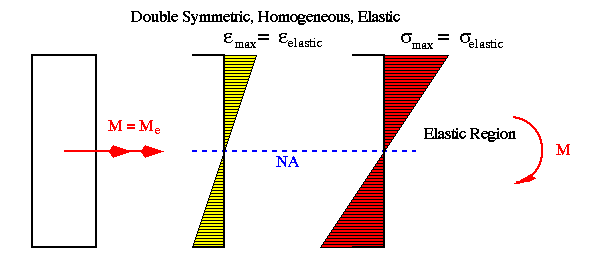
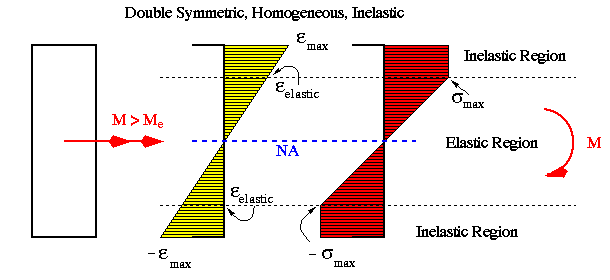
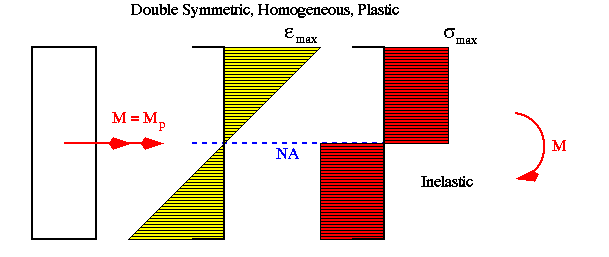
If in the previous example the stress-strain variation in compression was different from that in tension, then the position of N.A. would no longer coincide with the horizontal centroidal axis as beam is loaded beyond its elastic limit.
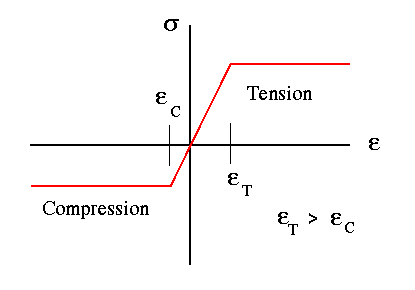

In such beam problems, the location of N.A. coincides with the horizontal centroidal axis when the beam is elastic. However, as it is loaded beyond the elastic limit, N.A. shift either up or down relative to the centroid depending on whether the material can carry more tension or compression. The farthest position of N.A. is determined by checking the cross-sectional stress variation for a fully plastic condition.
Helpful Observations in Inelastic Bending:
1. If the stress-strain variations in tension and compression are the same, then
a. N.A. coincides with the centroidal axis (same as moment axis) if the
cross section is symmetric about that axis.
b. N.A. does not conicide with the centroidal axis if the cross section is
unsymmetric about that axis.
2. If the stress-strain variations in tension and compression are different,
then
N.A. does not coincide with the centroidal axis regardless of cross-sectional
symmetry about that axis.
Determination of a Beam's Moment Capacity:
1. Check the stress-strain variations in compression and tension. Is there a difference between elastic limit stress in tension from that in compression?
2. Is the moment acting about the axis of symmetry or not?
3.
Case A. Moment is acting about the axis of symmetry and material properties
in compression and tension are the same.
Case B. Moment is acting about the axis of symmetry but material properties in
compression and tension are different.
Case C. Moment is acting about a centroidal axis which is not an axis of symmetry, and material properties in compression and tension are different. Example 1 below deals with such a problem.
 To Section II.5
To Section II.5